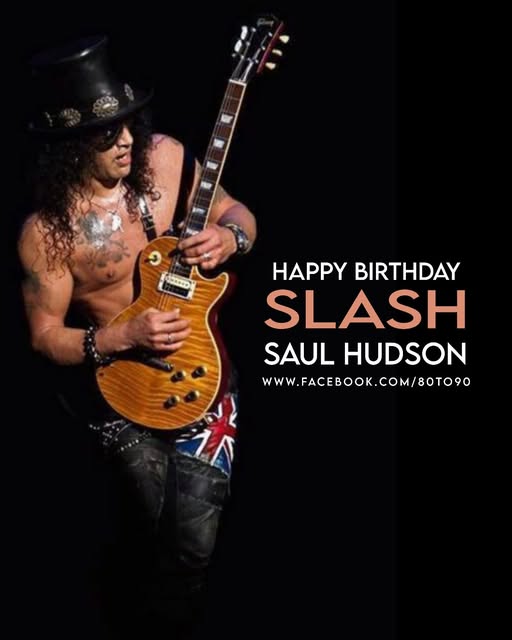
Happy 60th birthday to one of rock’s most iconic figures—Saul Hudson, known around the world as Slash. Born July 23, 1965, this top-hatted, curly-haired guitar god didn’t just play guitar—he redefined what it meant to feel the instrument. Whether shredding onstage with Guns N’ Roses or melting souls with a single bluesy bend, Slash carved his name into music history one riff at a time.
Six decades in, and Slash isn’t slowing down. He’s onstage, in the studio, and, most importantly, in the hearts of millions of fans who grew up on the gritty, unapologetic sound of hard rock—and those still discovering it today. Let’s celebrate the man behind the hat, the Les Paul, and the legacy.
From London to Los Angeles: The Origins of a Legend
Born in Hampstead, London, Saul Hudson was surrounded by creativity from day one. His mother, Ola, was a fashion designer who worked with David Bowie. His father, Anthony, created album art for legends like Neil Young and Joni Mitchell. The stage was set—quite literally—for a life in music.
At age six, Slash moved to Los Angeles with his father, trading England’s gray skies for California sun. But it wasn’t all glamour—just the right amount of chaos, inspiration, and grit that would eventually shape the sound of a generation.
His nickname? Slash was given to him by actor Seymour Cassel, who said young Saul was always darting around, on the move, full of energy. Fitting, since his guitar solos would later become the definition of lightning in musical form.
Enter: Guns N’ Roses
In 1985, after a stint with Hollywood Rose and a brush with glam metal’s rising scene, Slash joined a new group born from the ashes of Hollywood Rose and L.A. Guns. The name? Guns N’ Roses. The lineup? Legendary.
By 1987, Appetite for Destruction was unleashed on the world—a feral, booze-soaked, unapologetic rock masterpiece. Tracks like Welcome to the Jungle, Paradise City, and the immortal Sweet Child o’ Mine didn’t just put GNR on the map. They redrew the map.
Slash’s riffs were molten. His solos were cinematic. And his image—cigarette dangling, top hat low, Gibson Les Paul slung dangerously—became as iconic as the music itself.
Tension, Exit, and Reinvention
But as any fan knows, the Guns N’ Roses saga wasn’t all roses. By the early ’90s, creative tensions, internal battles, and the chaos of fame began to fracture the band. After years of turbulence, Slash officially left in 1996, following strained relations with frontman Axl Rose.
He didn’t disappear. He rebuilt.
First came Slash’s Snakepit in 1994—a gritty, no-holds-barred project that let him stretch his creative legs. Then in 2002, Slash co-founded Velvet Revolver, a hard rock supergroup with Stone Temple Pilots’ Scott Weiland. Their debut, Contraband, went multi-platinum and proved Slash wasn’t just a guitar hero—he was a survivor.
A Solo Career That Shreds On
Over the past two decades, Slash has become a genre-spanning force. His 2010 self-titled solo album featured rock royalty like Ozzy Osbourne, Chris Cornell, and Fergie. Yes, that Fergie—and she killed it.
Then came the full-time collaboration with Myles Kennedy & the Conspirators, a partnership that birthed a new chapter for Slash with albums like Apocalyptic Love (2012), World on Fire (2014), Living the Dream (2018), and 4 (2022). These records weren’t nostalgia—they were proof that Slash’s creativity is as sharp as ever.
And in 2024, Slash dropped Orgy of the Damned, a blues-soaked solo project packed with guest vocals that further cemented his legacy as one of the few guitarists who can play anything and make it sound like pure gold.
The Return of the King
In 2016, the impossible happened: Slash reunited with Guns N’ Roses. The “Not in This Lifetime…” tour became one of the highest-grossing tours of all time, raking in nearly half a billion dollars. Fans wept. Cities sold out. The chemistry? Still electric.
The return wasn’t just a reunion. It was a redemption arc. A reawakening. A realization that some things—like the bond between six strings and a soul—never truly fade.
Six Decades, Endless Impact
Slash isn’t just a guitarist. He’s a monument. A riff architect. A tone chaser. A rock ‘n’ roll lifer who still shreds harder at 60 than most do at 20.
His accolades are endless:
Time Magazine named him runner-up to Jimi Hendrix in their list of Top 10 Electric Guitarists.
Rolling Stone placed him at #65 on their list of 100 Greatest Guitarists of All Time.
His November Rain solo was ranked #6 in Guitar World’s Greatest Solos.
His Sweet Child o’ Mine riff? Voted #1 riff of all time by Total Guitar.
He was inducted into the Rock and Roll Hall of Fame in 2012 with Guns N’ Roses.
But beyond awards, Slash’s greatest legacy might just be inspiration. Legions of guitarists picked up their first instrument trying to learn Sweet Child o’ Mine. Millions more found catharsis in his solos, swagger in his riffs, and a bit of themselves in his sound.
What’s Next for Slash?
At 60, Slash isn’t thinking about retirement. He’s releasing music. Touring the world. Inspiring the next wave of rockers who will grow up idolizing him like he once idolized Page, Clapton, and Beck.
His riffs are eternal. His hat is still iconic. And his place in music history? Carved in stone—just like the face-melting solos that made him famous.
Happy Birthday, Legend
So here’s to Slash—60 years of fire, fretwork, and the unmistakable sound of a Les Paul screaming into the night. He gave rock its swagger, its soul, and its scream.
And he’s not done yet.
Happy Birthday, Slash. Keep the volume up, the solos long, and the top hat tilted. Rock and roll still needs you.

Leave a Reply